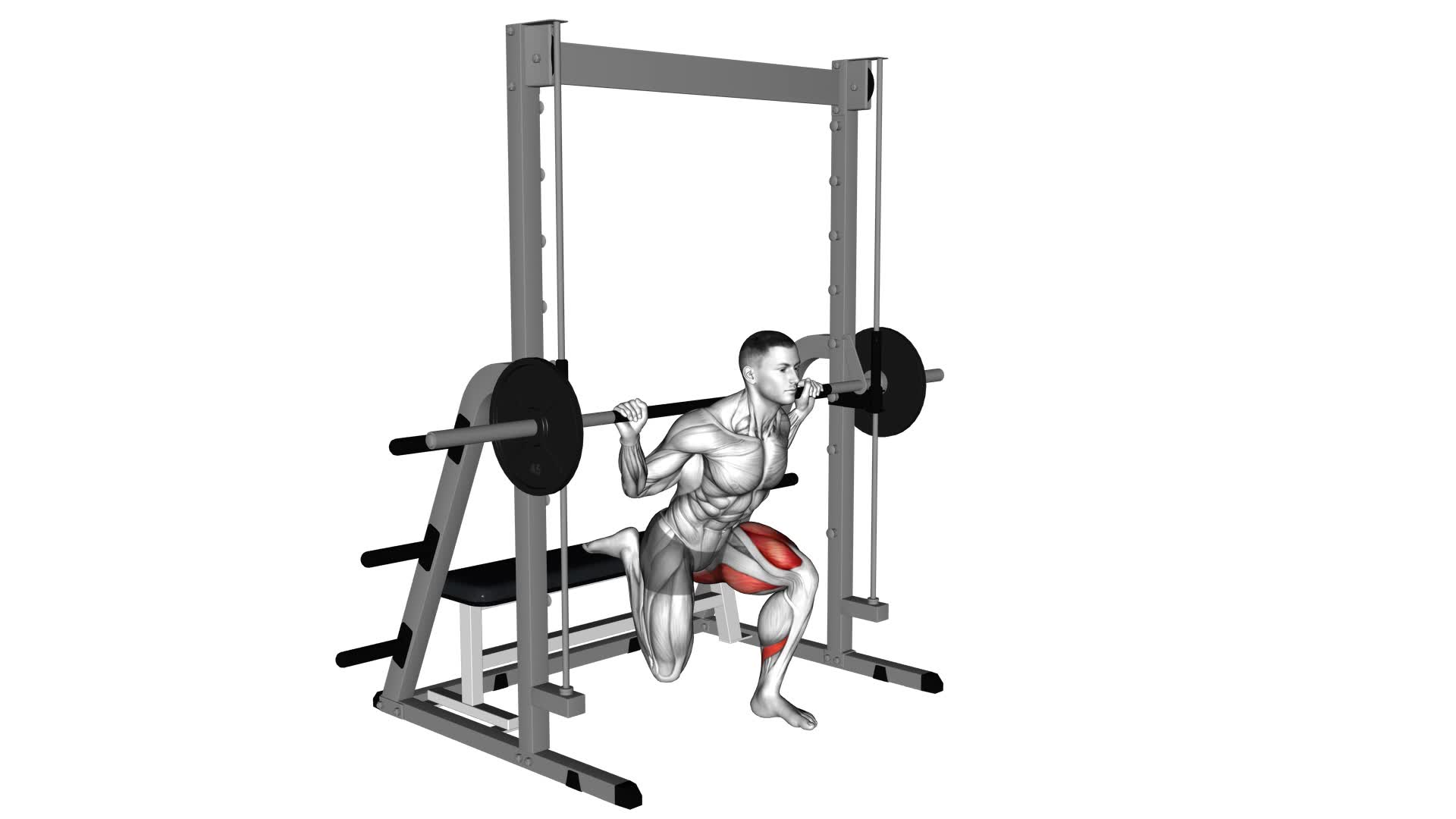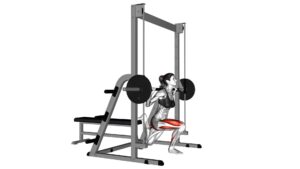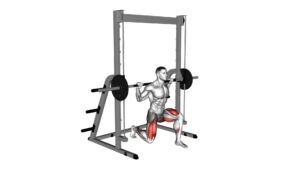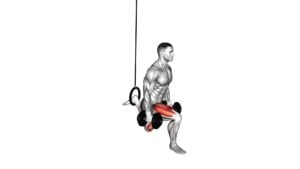Smith Single Leg Split Squat – Video Exercise Guide & Tips

Are you looking to strengthen your legs and improve your balance? The Smith Single Leg Split Squat is a great exercise to add to your routine.
Watch This Exercise Video
In this video exercise guide, we'll show you the proper form and technique, as well as variations and progressions to challenge yourself.
Avoid common mistakes and get the most out of your workout with these helpful tips.
Get ready to take your leg workout to the next level!
Key Takeaways
- Increased stability and strength in the lower body
- Injury prevention by strengthening the muscles surrounding the knees and ankles
- Addressing muscle imbalances between the left and right sides
- Muscle activation in the quadriceps, hamstrings, glutes, and calf muscles
Benefits of the Smith Single Leg Split Squat
You can experience increased stability and strength in your lower body by incorporating the Smith Single Leg Split Squat into your workout routine. This exercise offers numerous benefits, including injury prevention and muscle activation.
In terms of injury prevention, the Smith Single Leg Split Squat helps to strengthen the muscles surrounding your knees and ankles. By working these muscles, you can improve the stability of these joints, reducing the risk of injuries such as sprains or strains. Additionally, by focusing on one leg at a time, this exercise helps to address any muscle imbalances that may exist between your left and right sides, further reducing the risk of injury.
Furthermore, the Smith Single Leg Split Squat is highly effective in activating the muscles in your lower body. This exercise primarily targets your quadriceps, hamstrings, glutes, and calf muscles. By engaging these muscles, you can build strength and improve overall muscle tone in your lower body. This not only enhances your physical appearance but also translates into improved functional movement and performance in various activities, such as running, jumping, or even walking up stairs.
Incorporating the Smith Single Leg Split Squat into your workout routine can provide significant benefits in terms of injury prevention and muscle activation. By strengthening and stabilizing your lower body, you can improve your overall fitness and enhance your performance in daily activities and sports.
Equipment and Setup for the Exercise
To ensure a successful Smith Single Leg Split Squat, it's important to have the proper equipment selection and correct exercise setup.
First, choose a Smith machine with a weight that challenges you but allows for proper form.
Next, set the bar at a height that allows you to comfortably perform the exercise.
Proper Equipment Selection
Choose the appropriate equipment and set it up correctly for the Smith Single Leg Split Squat exercise. Proper equipment selection is crucial to ensure the effectiveness and safety of the exercise.
When performing the Smith Single Leg Split Squat, it's essential to use a Smith machine with a suitable weight rack. This machine provides stability and support, allowing you to focus on maintaining proper form throughout the exercise. Set the barbell at a height that allows you to comfortably perform the movement without compromising your form.
It's important to avoid common mistakes such as leaning too far forward, not maintaining a straight back, or using excessive weight. By selecting the appropriate equipment and setting it up correctly, you can enhance your workout and minimize the risk of injury.
Correct Exercise Setup
When setting up for the Smith Single Leg Split Squat exercise, ensure that you have the appropriate equipment and it's properly adjusted for your comfort and safety.
Start by selecting a Smith machine with a barbell and weight plates that are suitable for your fitness level. Adjust the barbell height so that it rests comfortably on your shoulders when you're in a split squat position.
Place one foot forward and the other foot back, with the back foot elevated on a bench or step. This exercise can also be modified by using a dumbbell or kettlebell instead of a barbell.
Proper alignment is crucial for this exercise, so make sure your front knee is aligned with your ankle and your back knee is hovering just above the floor.
Transitioning into the subsequent section about avoiding common mistakes, it's important to maintain proper form throughout the exercise to prevent injury.
Avoiding Common Mistakes
Ensure proper alignment and stability during the Smith Single Leg Split Squat exercise to maximize effectiveness and reduce the risk of injury. To prevent injuries and improve balance and stability, keep the following in mind:
- Maintain a neutral spine: Avoid rounding or arching your back to protect your spine.
- Position your feet correctly: Place your front foot far enough in front of the bar to maintain balance and stability.
- Engage your core: Activate your core muscles to stabilize your body throughout the movement.
- Control the descent: Lower your body with control, avoiding sudden drops or jerking movements.
Proper Form and Technique for the Smith Single Leg Split Squat
To perform the Smith Single Leg Split Squat with proper form and technique, it's important to stabilize your body while using a subordinating conjunction. This exercise can be challenging, but when done correctly, it can help strengthen your lower body and improve balance. One common mistake to avoid isn't maintaining proper alignment. Make sure your front knee is directly above your ankle, and your back knee is hovering just above the ground. Another mistake isn't engaging your core. Keep your abs tight throughout the movement to stabilize your body. Additionally, be mindful of your back foot placement. Keep it in line with your hips to maintain balance and prevent strain.
As for advanced modifications, you can increase the difficulty by adding weight or using a balance trainer. Holding a dumbbell or kettlebell in your hand will provide an extra challenge for your muscles. Alternatively, using a balance trainer, such as a BOSU ball, will require more stability and activate more muscles in your lower body.
Now that you understand the proper form and technique for the Smith Single Leg Split Squat, let's move on to exploring some variations and progressions for this exercise.
Variations and Progressions for the Exercise
Now that you have mastered the proper form and technique for the Smith Single Leg Split Squat, it's time to explore variations and progressions to challenge yourself even further.
Advanced modifications are available for beginners who want to gradually increase the difficulty of the exercise.
Incorporating variations not only keeps your workouts interesting, but also targets different muscles and enhances overall strength and stability.
Get ready to take your Smith Single Leg Split Squat to the next level and reap the benefits of these exciting modifications.
Advanced Modifications for Beginners
When progressing your Smith Single Leg Split Squat, you can start by incorporating advanced modifications to challenge yourself further. Here are some alternative exercises and beginner modifications to help you take your workout to the next level:
- Bulgarian Split Squat: This exercise involves elevating your back foot on a bench or step, increasing the range of motion and activating more muscles in your lower body.
- Weighted Split Squat: Hold dumbbells or a barbell in your hands to add resistance and increase the intensity of the exercise.
- Plyometric Split Squat: Add an explosive jump to your split squat, increasing power and improving athletic performance.
- Single Leg Squat to Bench: Lower yourself down to a bench or step, using it as a guide to maintain proper form and control.
Incorporating these advanced modifications into your Smith Single Leg Split Squat routine will help you continue challenging yourself and making progress in your fitness journey.
Benefits of Incorporating Variations
Incorporating variations into your Smith Single Leg Split Squat routine offers numerous benefits for your fitness journey. By adding progression variations to your workouts, you can challenge your muscles in new ways and prevent plateaus.
These variations can include using dumbbells or resistance bands to increase the intensity, performing the exercise on an unstable surface like a balance board or Bosu ball to improve stability, or incorporating explosive movements to enhance power and athleticism.
These variations not only keep your workouts interesting and engaging, but they also help maximize your results by targeting different muscle groups and improving overall strength and balance.
Common Mistakes to Avoid
To avoid common mistakes during the Smith Single Leg Split Squat exercise, focus on maintaining proper form and balance. Here are some key points to keep in mind:
- Proper Form: Ensure that your front knee is directly above your ankle and not extending past your toes. Keep your back straight and core engaged throughout the exercise. Avoid rounding your shoulders or arching your lower back.
- Balance: Find a stable position by distributing your weight evenly between your front and back legs. Keep your gaze forward and focus on a fixed point to help maintain balance. Avoid leaning too far forward or backward.
- Exercise Modifications: If you're new to this exercise or have limited mobility, start with a shorter range of motion. Use a step or platform to raise your back foot and decrease the depth of the squat. As you build strength and stability, gradually increase the range of motion.
- Avoid Rushing: Take your time with each repetition to ensure proper form and control. Avoid rushing through the exercise, as this can compromise your balance and increase the risk of injury.
By following these guidelines, you can perform the Smith Single Leg Split Squat with proper form and minimize the risk of common mistakes.
Now, let's move on to some tips for getting the most out of your Smith Single Leg Split Squat workout.
Tips for Getting the Most Out of Your Smith Single Leg Split Squat Workout
To maximize your results during the Smith Single Leg Split Squat workout, focus on maintaining proper form and engaging your muscles throughout the exercise. One important tip is to pay attention to your breathing technique. Proper breathing can help you stay focused and energized during the workout.
As you perform the split squat, inhale deeply before descending into the lunge and exhale as you push back up to the starting position. This will help you maintain control and stability throughout the movement.
Another tip to get the most out of your Smith Single Leg Split Squat workout is to gradually increase the intensity levels. Start with a weight that challenges you but still allows you to maintain proper form. As you become more comfortable and stronger, gradually increase the weight to continue challenging your muscles. You can also add variations to the exercise, such as holding dumbbells or a kettlebell for added resistance.
Remember to listen to your body and take breaks when needed. Pushing yourself too hard without proper rest can lead to injury. It's also important to warm up before the workout and stretch afterwards to prevent muscle soreness and promote recovery.
Frequently Asked Questions
How Many Sets and Reps Should I Do for the Smith Single Leg Split Squat?
You should start with a weight that challenges you but allows you to maintain proper form. As you progress, gradually increase the weight to continue challenging your muscles.
Aim for 3-4 sets of 8-12 reps for each leg. This will help build strength and stability in your lower body.
Avoid common mistakes like leaning too far forward or letting your knee collapse inward. Focus on maintaining good posture and engaging your glutes and quads throughout the exercise.
Can I Perform the Smith Single Leg Split Squat With Dumbbells Instead of Using the Smith Machine?
Yes, you can definitely perform the Smith Single Leg Split Squat with dumbbells instead of using the Smith machine.
Using dumbbells as an alternative to the Smith machine has its benefits.
Dumbbells allow for a greater range of motion and engage more stabilizer muscles, leading to improved balance and core strength.
Additionally, using dumbbells can increase the difficulty of the exercise and help you build more functional strength.
Is the Smith Single Leg Split Squat Suitable for Beginners?
Yes, the Smith Single Leg Split Squat can be suitable for beginners. It's a challenging exercise that targets your quads, glutes, and hamstrings.
To modify it for beginners, you can use a lighter weight or no weight at all. Focus on maintaining proper form and balance throughout the movement.
As you gain strength and confidence, you can gradually increase the weight and intensity. Remember to always listen to your body and consult with a fitness professional if needed.
What Muscles Does the Smith Single Leg Split Squat Primarily Target?
The Smith Single Leg Split Squat primarily targets your quadriceps, hamstrings, and glutes. This exercise is a great way to strengthen and tone these major muscle groups. By focusing on one leg at a time, you can help improve balance and stability.
Plus, the Smith machine provides added support and stability, making it suitable for beginners. There are also variations you can try, such as adding weights or using a step platform, to increase the intensity and challenge your muscles even more.
Can I Incorporate the Smith Single Leg Split Squat Into a Full Lower Body Workout Routine?
Yes, you can definitely incorporate the smith single leg split squat into a full lower body workout routine.
This exercise primarily targets your quadriceps, hamstrings, glutes, and calves, helping to strengthen and tone those muscles.
To progress or modify the smith single leg split squat, you can increase the weight, perform it on an unstable surface like a Bosu ball, or even add a plyometric jump at the top for an extra challenge.
Remember to always maintain proper form and listen to your body's limits.
Conclusion
In conclusion, the Smith Single Leg Split Squat is a highly effective exercise for building strength and stability in the lower body. By targeting one leg at a time, this exercise helps to correct muscle imbalances and improve overall balance and coordination.
With proper form and technique, variations and progressions can be added to continually challenge and progress in your workouts. Avoid common mistakes and follow these tips to maximize the results of your Smith Single Leg Split Squat routine.

Author
Years ago, the spark of my life’s passion ignited in my mind the moment I stepped into the local gym for the first time. The inaugural bead of perspiration, the initial endeavor, the very first surge of endorphins, and a sense of pride that washed over me post-workout marked the beginning of my deep-seated interest in strength sports, fitness, and sports nutrition. This very curiosity blossomed rapidly into a profound fascination, propelling me to earn a Master’s degree in Physical Education from the Academy of Physical Education in Krakow, followed by a Sports Manager diploma from the Jagiellonian University. My journey of growth led me to gain more specialized qualifications, such as being a certified personal trainer with a focus on sports dietetics, a lifeguard, and an instructor for wellness and corrective gymnastics. Theoretical knowledge paired seamlessly with practical experience, reinforcing my belief that the transformation of individuals under my guidance was also a reflection of my personal growth. This belief holds true even today. Each day, I strive to push the boundaries and explore new realms. These realms gently elevate me to greater heights. The unique combination of passion for my field and the continuous quest for growth fuels my drive to break new ground.







